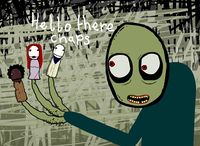Difference between revisions of "Required"
| (2 intermediate revisions by the same user not shown) | |||
| Line 7: | Line 7: | ||
*[[Not Required]] | *[[Not Required]] | ||
*[[Maybe sometimes but not always unless you want it to be Required]] | *[[Maybe sometimes but not always unless you want it to be Required]] | ||
| + | |||
| + | [[File:mr-salad-fingers1.jpg|200px|thumb|right|This is Edward Salad Fingers. Doesn't it remind you of the characters in Donna Leishman's "Deviant"?]] | ||
Latest revision as of 23:40, 6 November 2017
I am glad to have registered in this class during my final year at UCLA. Finally, a classroom without a pretentious vibe; students are genuinely intrigued and open to being creative. We are somewhat developing the class as we go, and being introduced to a new type of literature that I have never had previous interest in. I did not even know that the term "electronic literature" existed. Yes, Hayles give us an introduction to what type of pieces are considered electronic literature, but as it was mentioned in class: should this genre even be considered literature? This type of question reminds me of the Modern Art course that I took many years ago, because that was also an introduction course full of students who had not studied Modern Art before. How were we supposed to determine what was art or not? Because an esteemed artist claimed it to be? Because it was trending? Because history said so? Honestly, no one has the right to tell you what is and what is not art. If there is a connection between you and the piece, and you appreciate it solely for its beauty, emotional connection, creativity, or skill, then it certainly is art. Same goes with electronic literature – no one should be able to eliminate this genre. Regardless, this movement is unavoidable since we are extremely dependent on technology.
